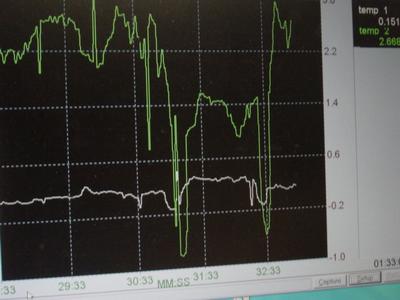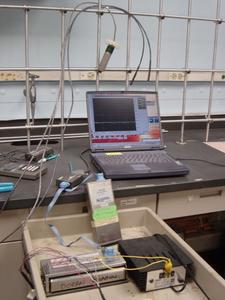5 August, 2003
When problem solving . . . do not forget to look for the obvious!
First thing this morning, Phil gave me a tour of the freezer facility
where the cores from Antarctica are stored. The walk in freezer is
kept at -20° C. Although this may be a bit colder than the typical
summer McMurdo Dry Valley temperature, it was comforting to remember
that while in Antarctica, plenty of extreme cold weather clothing
will be issued!
After the freezer tour, we got back to work on the "21X" datalogger,
which had successfully run the program we installed yesterday
throughout the night. We retrieved all the data and were poised for
our next assignment.
Phil and I "graduated" from the "21X" to the "CR10" Campbell
Scientific datalogger. We were given three probes; two measured only
temperature, while the third measured both temperature and relative
humidity. Our task was to hook up the two temperature probes so that
one measured in degrees Celsius and the other measured in degrees
Fahrenheit. The remaining probe would measure degrees Celsius and
relative humidity. We needed to program the system so that each
probe would take a reading every two seconds, the averages of each
probe would be calculated every five minutes, and the data would be
sent to the storage module every fifteen minutes.
While setting up the system, we noticed some fluctuations between the
two plain temperature probes. We wanted to trace the problem to see
if the disparity was due to a faulty probe, faulty programming, or a
faulty connection to the datalogger. The connections and programming
seemed in order, so we set up an ice water bath for each probe to
test their accuracy; both probes should register a "freezing"
temperature if functioning properly. We discovered a faulty probe,
labeled it as inaccurate so anyone using it in the future would know
it was defective. It would, however, work for our purposes, so we
continued with the programming.
Once the system was up and running, we asked the computer to display
a "real time" graph of the data being collected. To our dismay, only
two data sets were being shown where there should have been four
(three for temperature and one for relative humidity). This
discrepancy lead to a problem-solving marathon. We checked and
rechecked everything. We disassembled and reassembled the system.
We even rewrote the program, but still could only view two data sets
on the graph display. After considerable effort, Peter came in to
assist us with the problem. With the simple click of a button, the
graph started showing all four data sets. We had it set up correctly
all along - we simply had not told the graph to show us all four data
sets; we had only asked it to show us two! From now on we will not
forget to check the obvious when problems arise!

1) Phil switching connections from the "21X" to the "CR10" datalogger.

2) The Ice Water Bath to test the accuracy of the temperature probes.

3) Fluctuating readings!

4) System functioning properly; CR10 on bottom left, power source on bottom right, storage module behind the CR10 and power source, computer, three probes hanging above the computer.
Contact the TEA in the field at
.
If you cannot connect through your browser, copy the
TEA's e-mail address in the "To:" line of
your favorite e-mail package.
|
